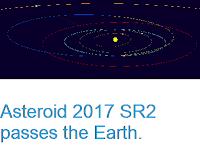Asteroid 2017 SS12 passed by the Earth at a distance of about 257 300
km (0.67 times the average distance between the Earth and the Moon, or
0.17% of the distance between the Earth and the Sun), slightly after 3.30 pm
GMT on Sunday 24 September 2017. There was no danger of
the asteroid hitting us, though were it to do so it would not have
presented a significant threat. 2017 SS12 has an estimated
equivalent
diameter of 7-23 m (i.e. it is estimated that a spherical object
with
the same volume would be 7-23 m in diameter), and an object of this
size would be expected to explode in
an airburst (an explosion caused by superheating from friction with the
Earth's atmosphere, which is greater than that caused by simply
falling, due to the orbital momentum of the asteroid) in the atmosphere between 36 and 25 km above the ground, with only fragmentary material
reaching the Earth's surface.
The calculated orbit of 2017 SS12 Minor Planet Center.
2017 SS12 was discovered on 25 September 2017 (the day after its closest approach to the Earth) by the University of Arizona's Catalina Sky Survey,
which is located in the Catalina Mountains north of Tucson. The
designation 2017 SS12 implies that it was the 618th asteroid (asteroid S12)
discovered in the second half of September 2017 (period 2017 S).
2017 SS12 has a 479 day orbital period and an eccentric orbit
tilted at an angle of 1.19° to the plane of the Solar System, which
takes it from 0.80 AU from the Sun (i.e. 80% of he average distance at
which the Earth orbits the Sun) to 1.60 AU from the Sun (i.e. 160% of the
average distance at which the Earth orbits the Sun, slightly more
distant from the Sun than the planet Mars). It is therefore
classed as an
Apollo Group Asteroid (an asteroid that is on average further from the
Sun than the Earth, but which does get closer). This means that close
encounters between the asteroid and Earth are extremely common, with the
last thought to have happened in October 2013 next predicted
in March 2024.
2017 SS12 also
has frequent close encounters with the planets Venus, which it is
thought to have last passed in May 2010 and is next predicted to come close to in April 2054, and Mars which it last came
close to in May 2015, and is next predicted to come close to January 2040. Asteroids
which make close passes to multiple planets are considered to be in
unstable orbits, and are often eventually knocked out of these orbits by
these encounters, either being knocked onto a new, more stable orbit,
dropped into the Sun, knocked out of the Solar System or occasionally
colliding with a planet.
See also







